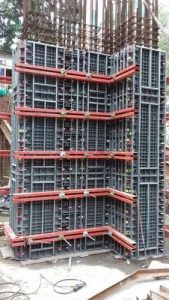Concrete Structures
Formwork construction is a vital stage in the process of creating concrete structures. It is a temporary structure that supports the weight of the freshly placed concrete, as well as construction live loads including materials and workers. It also controls the position and alignment of the concrete. Effective formwork design results in great optimization of the construction process.
Traditional formwork construction consists of bespoke solutions requiring skilled craftsmen. However, modern formwork systems provide a wide range of concrete construction solutions for various applications and most have enhanced safety features built-in. Concrete contractors should evaluate several forming systems before choosing one for a project.
The erection of formwork should be done progressively. This ensures installers’ safety and stabilises the overall structure. Side bracing should be attached to formwork frames as soon as practicable and designated access ways must be clearly indicated. When a formwork deck is being constructed adjacent to stairs it is recommended that a stair access system be used. If this is not practicable, a secured industrial ladder should be employed. Edge protection should be provided to minimise a person falling off the deck.
After the concrete has set, the formwork can be disassembled and removed (called “stripping” in construction parlance). The forms can then be repositioned elsewhere on the job site, stockpiled for later use or destroyed if they are no longer required. In the past, plywood formwork was common, but it is being replaced by more efficient and reusable steel formworks.

Formwork Construction in Concrete Structures
A reputable supplier will be able to advise on the correct system for a project. This includes evaluating the conditions and constraints at a particular construction site to ensure the best solution is available. They can also advise on the most efficient method of assembling and erecting the formwork, as well as reducing the risk of potential hazards during the concreting process.
Formwork erecting and stripping must be carefully coordinated with the pour schedule to minimize the impact on construction progress. It is important to have a competent designated observer continuously monitoring the formwork assembly during concrete placement to ensure that horizontal and vertical movement do not exceed specifications. A designated observer must also be present to carry out emergency adjustments and repairs if necessary.
During concrete pouring the formwork is subjected to high levels of vibration and pressure. The resulting deformations can be significant and require the re-establishment of the original geometry. If the formwork is not adequately stabilised, it can collapse or become unsafe for the people working inside.
In addition to being a health and safety risk, the movement of the joists can cause damage to the surrounding structural members and equipment. This can be costly and result in delays in the pouring of concrete, which can increase construction costs. To avoid this, a formwork designer should incorporate controls to minimise the sideways movements of joists when a slab is being constructed on-deck.